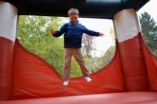(Press-News.org) CHICAGO – Both very high and very low levels of physical activity can accelerate the degeneration of knee cartilage in middle-aged adults, according to a new study presented at the annual meeting of the Radiological Society of North America (RSNA).
Nearly one in every two people in the U.S. may develop knee osteoarthritis by age 85, according to the Centers for Disease Control and Prevention. By 2030, an estimated 67 million Americans over the age of 18 are projected to have physician-diagnosed arthritis.
Researchers at the University of California in San Francisco (UCSF) previously had found an association between physical activity and cartilage degeneration. But that study focused on one point in time.
For the new study, the UCSF researchers looked at changes in knee cartilage among a group of middle-aged adults over a four-year period. They used magnetic resonance imaging (MRI)-based T2 relaxation times to track the evolution of early degenerative cartilage changes in the knee.
"T2 relaxation times generated from MR images allow for analysis of the biochemical and molecular composition of cartilage," said Wilson Lin, B.S., research fellow and medical student at UCSF. "There is increased water mobility in damaged cartilage, and increased water mobility results in increased T2 relaxation time."
The researchers analyzed 205 patients, age 45 to 60, from the UCSF-based Osteoarthritis Initiative, a nationwide study funded by the National Institutes of Health on the prevention and treatment of knee osteoarthritis. Participants used a questionnaire to record their physical activity. The researchers measured T2 values of cartilage at the patella, femur and tibia of the right knee joint at baseline and at two- and four-year visits.
According to the results of the study, participating frequently in high-impact activities, such as running, appears associated with more degenerated cartilage and potentially a higher risk for development of osteoarthritis.
"When we compared the scores among groups, we found an accelerated progression of T2 relaxation times in those who were the most physically active," said Thomas M. Link, M.D., professor of radiology and chief of musculoskeletal imaging at UCSF. "Those who had very low levels of activity also had accelerated progression of T2 values. This suggests that there may be an optimal level of physical activity to preserve the cartilage."
The results open up numerous areas for future inquiry, including analysis of the impact of specific types of physical activity on knee cartilage health. For instance, some of the participants in the Osteoarthritis Initiative wore an accelerometer, a device with a motion sensor to record physical activity.
"In this study, we used the subjective measure of a questionnaire," Lin said. "The accelerometers provide a more objective way to measure physical activity."
Along with the findings on changes in knee cartilage, the study also highlighted the potential of T2 relaxation times as an early indicator of cartilage degeneration.
"Standard MRI shows cartilage defects that are irreversible," Dr. Link said. "The exciting thing about the new cartilage T2 measurements is that they give us information on a biochemical level, thus potentially detecting changes at an earlier stage when they may still be reversible."
Dr. Link noted that people who have a higher risk for osteoarthritis (such as family history of total joint replacement, obesity, history of knee injury or surgery) can reduce their risk for cartilage degeneration by maintaining a healthy weight and avoiding risky activities and strenuous, high-impact exercise.
"Lower impact sports, such as walking or swimming, are likely more beneficial than higher impact sports, such as running or tennis, in individuals at risk for osteoarthritis," he said.
###
Coauthors are Waraporn Srikhum, M.D., Charles E. McCulloch, Ph.D., Michael Neitt, Ph.D., John Lynch, Ph.D., Gabby B. Joseph, Ph.D., and Hamza Alizai, M.D.
Note: Copies of RSNA 2012 news releases and electronic images will be available online at RSNA.org/press12 beginning Monday, Nov. 26.
RSNA is an association of more than 50,000 radiologists, radiation oncologists, medical physicists and related scientists, promoting excellence in patient care and health care delivery through education, research and technologic innovation. The Society is based in Oak Brook, Ill.
Editor's note: The data in these releases may differ from those in the published abstract and those actually presented at the meeting, as researchers continue to update their data right up until the meeting. To ensure you are using the most up-to-date information, please call the RSNA Newsroom at 1-312-949-3233.
For patient-friendly information on MRI of the knee, visit RadiologyInfo.org.
CHICAGO – An active lifestyle helps preserve gray matter in the brains of older adults and could reduce the burden of dementia and Alzheimer's disease (AD), according to a study presented today at the annual meeting of the Radiological Society of North America (RSNA).
Dementia exacts a staggering toll on society. More than 35 million people worldwide are living with the disease, according to the World Health Organization, and the prevalence is expected to double by 2030. AD is the most common cause of dementia and currently has no cure.
Cyrus Raji, M.D., Ph.D., radiology ...
CHICAGO – Using a special magnetic resonance imaging (MRI) technique to image patients with mild traumatic brain injury (MTBI), researchers have identified a biomarker that may predict which patients will do well over the long term, according to a study presented today at the annual meeting of the Radiological Society of North America (RSNA).
The results of the study showed that in some patients the brain may have changed to compensate for the damage caused by the injury.
"This finding has huge potential implications for preventing and repairing the damage that accompanies ...
CHICAGO – All patients with Alzheimer's disease (AD) lose brain cells, which leads to a shrinking, or atrophy, of the brain. But the pattern of gray matter loss is significantly different in men and women, according to a study presented today at the annual meeting of the Radiological Society of North America (RSNA).
"We found that the extent and distribution of regional gray matter volume loss in the brain was strongly influenced by gender," said lead researcher Maria Vittoria Spampinato, M.D., associate professor of radiology at the Medical University of South Carolina ...
VIDEO:
Inflatable bouncers such as bounce houses, slides or obstacle courses are the new craze for kids' birthday parties and/or celebrations. While they appear to be a fun activity for a...
Click here for more information.
A new study by researchers at the Center for Injury Research and Policy of The Research Institute at Nationwide Children's Hospital examined pediatric injuries associated with inflatable bouncers, such as bounce houses and moonwalks. Researchers found ...
November 26, 2012 – (BRONX, NY) – Researchers at Albert Einstein College of Medicine of Yeshiva University and Montefiore Medical Center have found that a special magnetic resonance imaging (MRI) technique may be able to predict which patients who have experienced concussions will improve. The results, which were presented today at the annual meeting of the Radiological Society of North America (RSNA), suggest that, in some patients, the brain may change to compensate for the damage caused by the injury.
"This finding could lead to strategies for preventing and repairing ...
Metallic glass alloys (or liquid metals) are three times stronger than the best industrial steel, but can be molded into complex shapes with the same ease as plastic. These materials are highly resistant to scratching, denting, shattering and corrosion. So far, they have been used in a variety of products from golf clubs to aircraft components. And, some smartphone manufacturers are even looking to cast their next-generation phone cases out of it.
But despite their potential, the mechanical properties of these substances are still a scientific mystery. One lingering question ...
PULLMAN, Wash.—Scientists and business people have known for decades that certain scents—pine boughs at Christmas, baked cookies in a house for sale—can get customers in the buying spirit. Eric Spangenberg, a pioneer in the field and dean of the Washington State University College of Business, has been homing in on just what makes the most commercially inspiring odor.
Spangenberg and colleagues at WSU and in Switzerland recently found that a simple scent works best.
Writing in the Journal of Retailing, the researchers describe exposing hundreds of Swiss shoppers to simple ...
BLOOMINGTON, Ind. -- What types of public messages will most likely deter drug and alcohol abuse or dissuade people from engaging in risky behavior? Negatively framed messages may not be an effective way to reach those most in need of persuasion, suggests a new study in Psychology of Addictive Behaviors by researchers from Indiana University and Wayne State University.
"The findings are somewhat ironic because a whole lot of public service announcements say, 'Drugs are bad for you,' 'Just say no,' or 'This is your brain on drugs' with an image of an egg frying," said ...
BLOOMINGTON, Ind. -- An Indiana University study in the Journal of Child Neurology proposes an innovative treatment for developmental coordination disorder, a potentially debilitating neurological disorder in which the development of a child's fine or gross motor skills, or both, is impaired.
DCD strikes about one in 20 children, predominantly boys, and frequently occurs alongside ADHD, autism spectrum disorders and other better known conditions. Like ADHD, DCD has broad academic, social and emotional impact. It can severely affect reading, spelling and handwriting abilities; ...
Park Regis Kris Kin Hotel Dubai hosted a leading press delegation from the UK recently. The journalists representing popular regional English publications such as The Liverpool Echo, South Wales Echo, Western Daily Press, Bristol Evening Post, The Western Daily Press and Southern Daily Echo were flown in by Dubai Department of Tourism and Commerce Marketing (DTCM) to promote the emirates and its numerous attractions.
In addition to a show-around of the hotel and its facilities, the highlight of the fam trip was an exclusive evening held at the Kris Lounge. Mr Scott Butcher, ...



